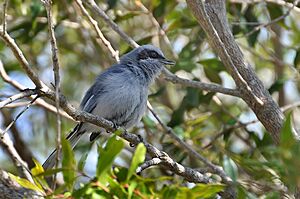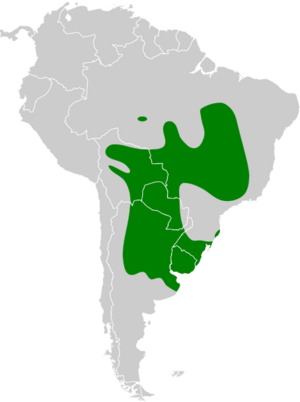Masked gnatcatcher facts for kids
Quick facts for kids Masked gnatcatcher |
|
|---|---|
 |
|
| Male at Rocha, Uruguay | |
 |
|
| Female at Santa Fe Province, Argentina | |
| Conservation status | |
| Scientific classification | |
| Genus: |
Polioptila
|
| Species: |
dumicola
|
 |
|
The masked gnatcatcher (Polioptila dumicola) is a small songbird that lives in parts of South America. It belongs to a bird family called Polioptilidae. You can find this little bird in countries like Argentina, Bolivia, Brazil, Paraguay, and Uruguay.
Contents
What is a Masked Gnatcatcher?
The masked gnatcatcher is a small bird, usually about 12 to 13 centimeters (around 5 inches) long. It weighs only 5 to 7 grams, which is about as much as a few paper clips! This makes it a bit bigger than most other gnatcatchers.
How to Spot a Masked Gnatcatcher
Male masked gnatcatchers have a cool "mask" on their face. This mask is black, with a thin white line just below it. Their head and upper body are a pretty blue-gray color. Their tail is mostly black with white feathers on the outside. Their throat is light gray, turning whitish on their belly.
Female masked gnatcatchers look a little different. They don't have the full black mask. Instead, they have a black crescent shape that goes down from their eye. Their upper body colors are not as bright or bluish as the males.
Different Kinds of Masked Gnatcatchers
There are three main types, or subspecies, of the masked gnatcatcher. They are called Polioptila dumicola dumicola, P. d. saturata, and P. d. berlepschi. The berlepschi type looks and sounds quite different from the other two. Some scientists even think it might be a separate species!
- The P. d. saturata type is darker than the others. It has a slate gray color all over, which is lighter on its underside.
- The male P. d. berlepschi is paler than the main type. It's dull gray on top and white underneath, with a thinner mask. The female berlepschi is also paler than the main type of female.
Where Do Masked Gnatcatchers Live?
Masked gnatcatchers live in different parts of South America, depending on their subspecies.
- The main type, Polioptila dumicola dumicola, lives in Paraguay, southern Brazil, Uruguay, and eastern Argentina. It might also be found in southeastern Bolivia.
- The P. d. saturata type lives in the highlands of Bolivia, south of the Cochabamba Department.
- The P. d. berlepschi type is found in central Brazil, reaching as far north as Mato Grosso and Amazonas. It probably also lives in eastern Bolivia.
Their Favorite Homes
These birds like different kinds of places to live:
- The main type of gnatcatcher is often found in the Gran Chaco area. They also live in Humid Chaco and different types of savanna grasslands. They usually live in places less than 1,000 meters (about 3,300 feet) high.
- The P. d. saturata type prefers dry montane forests. These are forests in mountains, usually between 1,500 and 2,000 meters (about 4,900 to 6,600 feet) high. This is one of the highest places any gnatcatcher lives!
- The P. d. berlepschi type lives in areas like the Cerrado and Pantanal. These places have trees that are spread out, not a thick, continuous forest.
Masked Gnatcatcher Behavior
What Do Masked Gnatcatchers Eat?
Masked gnatcatchers love to eat small arthropods, which are tiny creatures like insects and spiders. They usually look for food high up in the trees. They hop along branches, picking off bugs. They can also hover in the air to grab flying insects. These birds often hunt alone or in pairs. Sometimes, they join groups of different bird species looking for food together.
Reproduction and Life Cycle
Scientists have mostly studied the breeding habits of the main type of masked gnatcatcher. Their breeding season runs from September to January.
Their nest is a small, deep cup made from plant fibers. They use spider silk to hold it all together! To hide the nest, they stick lichens (small plant-like growths) to the outside. A female usually lays three eggs, but sometimes up to five. Both the male and female birds take turns sitting on the eggs to keep them warm. They also both help feed the baby birds once they hatch. Sometimes, other birds like shiny cowbirds try to lay their eggs in the gnatcatcher's nest, making the gnatcatchers raise their babies.
What Do They Sound Like?
The main type of masked gnatcatcher has a loud song that is "variable, short, sweet and musical" [1]. The P. d. berlepschi type has a very different loud song [2]. These birds also make a variety of other calls [3] [4].
Status of the Masked Gnatcatcher
The IUCN (International Union for Conservation of Nature) has looked at the masked gnatcatcher as a whole. They consider it a species of "Least Concern." This means it's not currently in danger of disappearing. The main type and the berlepschi type seem to be doing well. However, the saturata type is thought to be at serious risk. This is because people are building more homes and turning land into farms where these birds live.


